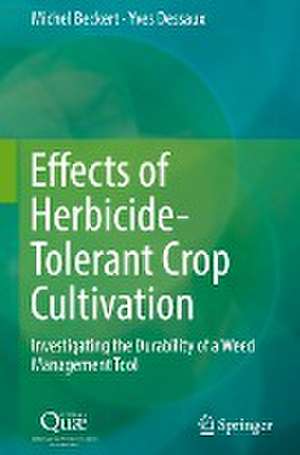Effects of Herbicide-Tolerant Crop Cultivation: Investigating the Durability of a Weed Management Tool
Autor Michel Beckert, Yves Dessauxen Limba Engleză Hardback – 2 mar 2017
| Toate formatele și edițiile | Preț | Express |
|---|---|---|
| Paperback (1) | 548.21 lei 38-44 zile | |
| SPRINGER NETHERLANDS – 13 iul 2018 | 548.21 lei 38-44 zile | |
| Hardback (1) | 660.18 lei 3-5 săpt. | |
| SPRINGER NETHERLANDS – 2 mar 2017 | 660.18 lei 3-5 săpt. |
Preț: 660.18 lei
Preț vechi: 776.67 lei
-15% Nou
Puncte Express: 990
Preț estimativ în valută:
126.34€ • 131.10$ • 105.60£
126.34€ • 131.10$ • 105.60£
Carte disponibilă
Livrare economică 22 februarie-08 martie
Preluare comenzi: 021 569.72.76
Specificații
ISBN-13: 9789402410068
ISBN-10: 9402410066
Pagini: 149
Ilustrații: XXI, 146 p. 19 illus., 16 illus. in color.
Dimensiuni: 155 x 235 mm
Greutate: 0.97 kg
Ediția:1st ed. 2016
Editura: SPRINGER NETHERLANDS
Colecția Springer
Locul publicării:Dordrecht, Netherlands
ISBN-10: 9402410066
Pagini: 149
Ilustrații: XXI, 146 p. 19 illus., 16 illus. in color.
Dimensiuni: 155 x 235 mm
Greutate: 0.97 kg
Ediția:1st ed. 2016
Editura: SPRINGER NETHERLANDS
Colecția Springer
Locul publicării:Dordrecht, Netherlands
Cuprins
Foreword.- 1. Mechanisms of herbicide resistance and HTV breeding techniques.- 1.1. From herbicide modes of action to genetic determinants of the HT trait.- 1.2. Introducing the HT trait into the genome of a cultivated species.- 1.3. Perspectives on the evolution of HTV breeding techniques.- 1.4. Existing HTVs.- Conclusions.- 2. HTV diffusion and use.- 2.1. HTV adoption worldwide.- 2.2. Possible drivers of HTV adoption.- 2.3. The North American example: the expansion of transgenic HTVs and its consequences.- 2.4. Specificities of the social and regulatory context of HTV adoption in Europe.- Conclusions.- 3. Diffusion of the HT trait and the appearance of herbicide resistance.- 3.1. Mechanisms and consequences of HT trait diffusion.- 3.2. The spontaneous appearance of resistant weeds.- Conclusions.- 4. The development of HTV cropping systems.- 4.1. Effects on weed flora of HTV adoption and associated practices.- 4.2. Conditions specific to the introduction of HTVs inFrance.- Conclusions.- 5. Effects on the environment.- 5.1. Environmental contamination: wetlands and soil.- 5.2. Herbicide residues in and on crop plants.- 5.3. Impacts of HTVs on wild biodiversity.- Conclusions.- General conclusions.- Annex 1. Mission statement for the HTV ESCo.- Annex 2. HRAC classification of herbicides according to site of action.
Textul de pe ultima copertă
In France in 2009, several crop destruction campaigns targeted herbicide-tolerant (HT) sunflowers obtained by mutagenesis. Facing this emerging debate on HT crops, the French Ministries in charge of Agriculture and of Ecology asked INRA and CNRS to gather analytical elements with regard to the real effects, both medium and long-term, of the cultivation of HT crops. This book presents the results of a multidisciplinary expert report on these questions, based on a review of the international literature. HT crops may seem to be useful complementary tools when farmers are facing certain difficult weed-management situations or in the context of a diversification of weed-control strategies. Their repeated use, however, can rapidly induce changes int he weed flora that can constitute more complex challenges in terms of weed control. Issues coming up with the development of agricultural production systems including HT crops are the objects of this expert report: what are the perceptionsof these varieties by society and the reasons for the adoption by farmers? Are the savings on herbicides promoted by seed companies long-lasting? Can the cultivation of HT crops impact biodiversity? Overall, this work identifies key points to be taken into account when drawing up guidelines that govern the use of HT crops in order to preserve the effectiveness of this innovation over time.
A working group was set up from July 2010 to November 2011, including specialists in ecology, agronomy, herbicide chemistry, genetics, economics, sociology and law. the full report is supported by a bibliographic corpus of more than 1,500 references, assembled by three documentation specialists. it is composed primarily of international peer-reviewed scientific articles, complemented by statistical data, monographs and technical reports. From these references, the experts have extracted, analysed and assembled the relevant elements to clarify the questions at hand.
Caracteristici
This work uses an original multidisciplinary approach to the effects of HT crops cultivation Unlike most studies, this work focuses on the agronomic HT tait in crops, not on the consequences of plant-breeding technology (transgenic vs. non-transgenic) In the European context where a social contestation of cultivating GMOs can be found, this expert report is a pragmatic, robust and dispassionate examination of the impacts of HT crops Includes supplementary material: sn.pub/extras
